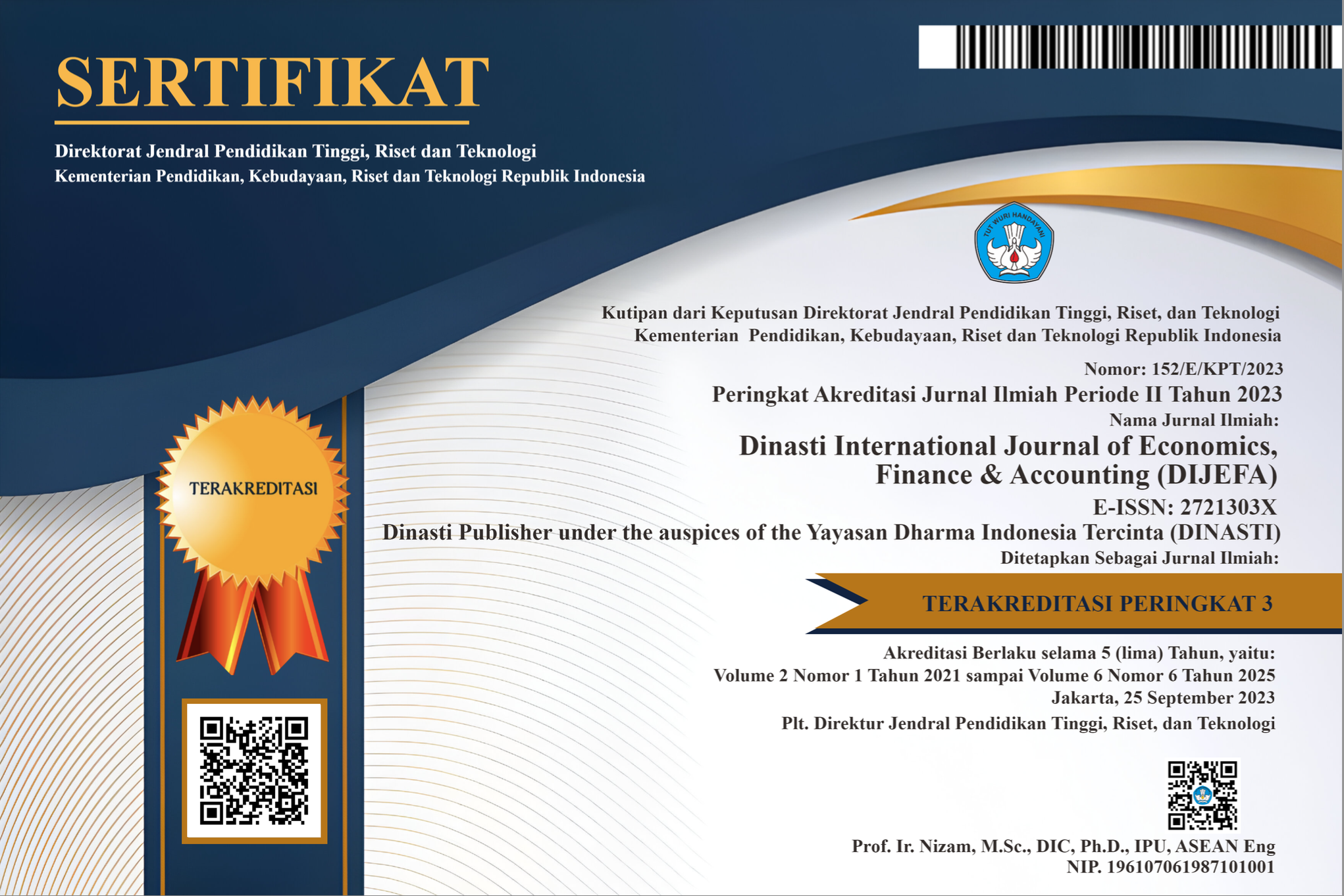Analysis of Factors Influencing Intention to Purchase Natural And Environmentally Friendly Cosmetic Products
DOI:
https://doi.org/10.38035/dijefa.v5i6.3726Keywords:
Green Product, Environmental Concern, Health Consciousness, Green Cosmetic Purchase Intention, Behavioral IntentionAbstract
The popular trend in the global beauty industry has reshaped consumer consumption patterns, including in Indonesia. However, the unsustainable consumption of cosmetic products poses risks to environmental and social sustainability. With the phenomenal growth of the rapidly expanding cosmetic industry, the consumption of cosmetic products has also increased significantly. Unfortunately, this increase has negative environmental impacts and can harm consumer health. This is due to waste from raw materials used in production, product packaging, and chemicals that may pose health risks to consumers. Alternatively, green products have been widely developed and are available in the market. This study aims to examine the factors influencing the purchase intention of natural and eco-friendly cosmetic products among Indonesian consumers. To establish a hypothesis framework, 161 valid questionnaires were collected through purposive sampling in several cities in Indonesia. Data analysis and hypothesis testing were conducted using SmartPLS statistical software. The study results indicate that Indonesian consumers’ purchase intentions for natural and eco-friendly cosmetic products tend to be positively influenced by consumers’ attitudes toward environmental concern, health consciousness, and perceived behavioral control. Additionally, purchase intention positively impacts behavioral intention. These findings provide insights into Indonesian consumers' habits and awareness in choosing natural and eco-friendly cosmetic products.
References
Al Mamun, A., Mohamad, M. R., Yaacob, M. R. Bin, & Mohiuddin, M. (2018). Intention and behavior towards green consumption among low-income households. Journal of Environmental Management, 227, 73–86. https://doi.org/10.1016/J.JENVMAN.2018.08.061
Asha, P. (n.d.). Article ID: IJM_08_05_002-Cite this Article: P. Asha and R. Rathiha, Consumer Awareness Towards Green Products. International Journal of Management (IJM, 8(5), 8–14. http://iaeme.com/Home/journal/[email protected]://iaeme.com/Home/issue/IJM?Volume=8&Issue=5JournalImpactFactor
Choi, D., & Johnson, K. K. P. (2019). Influences of environmental and hedonic motivations on intention to purchase green products: An extension of the theory of planned behavior. Sustainable Production and Consumption, 18, 145–155. https://doi.org/10.1016/J.SPC.2019.02.001
Echegaray, F., & Hansstein, F. V. (2017). Assessing the intention-behavior gap in electronic waste recycling: the case of Brazil. Journal of Cleaner Production, 142, 180–190. https://doi.org/10.1016/J.JCLEPRO.2016.05.064
Fonseca, J. (2015). The impact of green marketing practices on consumer buying decision. https://search.proquest.com/openview/1dddde43a5bf6e6e80f3b422622a57f0/1?pq-origsite=gscholar&cbl=2026366&diss=y
Givan, B., Ecodemica, S. W.-J., & 2019, undefined. (2019). Green Product Dan Gaya Hidup Pengaruhnya Pada Keputusan Pembelian (Studi Kasus Natural Coffee). Repository.Bsi.Ac.IdB Givan, SH WinarnoJurnal Ecodemica, 2019•repository.Bsi.Ac.Id, 3(1). https://repository.bsi.ac.id/repo/files/237269/download/JURNAL-ECODEMICA-genap-2018-2019-Bryan-Givan_B1.pdf
Hair, J. F., Sarstedt, M., Hopkins, L., & Kuppelwieser, V. G. (2014). Partial least squares structural equation modeling (PLS-SEM): An emerging tool in business research. European Business Review, 26(2), 106–121. https://doi.org/10.1108/EBR-10-2013-0128/FULL/HTML
Hoque, M., Alam, M., Foods, K. N.-, & 2018, undefined. (n.d.). Health consciousness and its effect on perceived knowledge, and belief in the purchase intent of liquid milk: Consumer insights from an emerging market. Mdpi.ComMZ Hoque, MN Alam, KA NahidFoods, 2018•mdpi.Com. Retrieved June 30, 2024, from https://www.mdpi.com/2304-8158/7/9/150
Kim, H. Y., & Chung, J. E. (2011). Consumer purchase intention for organic personal care products. Journal of Consumer Marketing, 28(1), 40–47. https://doi.org/10.1108/07363761111101930/FULL/HTML
Kumar Azad, P., & Kumar Laheri, V. (2014). View of Consumer Adoption of Green Products and their Role in Resource Management. https://www.ijcms.in/index.php/ijcms/article/view/364/342
Kusumawati, E. (2019). Minat Beli Produk Ramah Lingkungan Sebagai Dampak dari Implementasi Green Advertising. 19(1).
Novita, N., Nurdin, & Putri, R. D. (2020). Pengaruh... - Google Scholar. (n.d.). Retrieved June 30, 2024, from https://scholar.google.com/scholar?hl=en&as_sdt=0%2C5&q=Novita%2C+N.%2C+Nurdin%2C+%26+Putri%2C+R.+D.+%282020%29.+Pengaruh+Green+Perceived+Knowledge+dan+Environmental+Concern+Terhadap+Eco-Friendly+Behavior.+Economic+Education+and+Entrepreneurship+Journal%2C+3%281%29%2C+35%E2%80%9350.+http%3A%2F%2Fjurnal.fkip.unila.ac.id%2Findex.php%2FE3J%2Farticle%2Fview%2F21940&btnG=
Pagiaslis, A., & Krontalis, A. K. (2014). Green Consumption Behavior Antecedents: Environmental Concern, Knowledge, and Beliefs. Psychology & Marketing, 31(5), 335–348. https://doi.org/10.1002/MAR.20698
Parashar, S., Singh, S., & Sood, G. (2023). Examining the role of health consciousness, environmental awareness and intention on purchase of organic food: A moderated model of attitude. Journal of Cleaner Production, 386. https://doi.org/10.1016/J.JCLEPRO.2022.135553
Park, H. J., & Lin, L. M. (2020). Exploring attitude–behavior gap in sustainable consumption: comparison of recycled and upcycled fashion products. Journal of Business Research, 117, 623–628. https://doi.org/10.1016/J.JBUSRES.2018.08.025
Pratama, I., & Suryani, A. (2017). Peran Green Satisfaction Memediasi Hubungan Green Brand Image terhadap Green Brand Equity. http://download.garuda.kemdikbud.go.id/article.php?article=1369217&val=989&title=PERAN%20GREEN%20SATISFACTION%20MEMEDIASI%20HUBUNGAN%20GREEN%20BRAND%20IMAGE%20TERHADAP%20GREEN%20BRAND%20EQUITY
Rinaldo Fernandes, A. A., Darmanto, Astuti, A. B., Solimun, Amaliana, L., Nurjannah, Yanti, I., Arisoesilaningsih, E., & Isaskar, R. (2019). Smoothing Spline Nonparametric Path: Application for Green Product and Green Marketing Strategy towards Green Product Purchasing Intention. IOP Conference Series: Earth and Environmental Science, 239(1), 012018. https://doi.org/10.1088/1755-1315/239/1/012018
Shin, J., & Mattila, A. S. (2019). When organic food choices shape subsequent food choices: The interplay of gender and health consciousness. International Journal of Hospitality Management, 76, 94–101. https://doi.org/10.1016/J.IJHM.2018.04.008
Sreen, N., Purbey, S., consumer, P. S.-J. of retailing and, & 2018, undefined. (2017). Impact of culture, behavior and gender on green purchase intention. ElsevierN Sreen, S Purbey, P SadaranganiJournal of Retailing and Consumer Services, 2018•Elsevier, 41, 177–189. https://doi.org/10.1016/j.jretconser.2017.12.002
Sutikno, V., & Anandya, D. (2021). FAKTOR YANG MEMPENGARUHI GREEN PURCHASE BEHAVIOR GENERASI MILENIAL DI INDONESIA. Jurnal MEBIS (Manajemen Dan Bisnis), 6(1), 23–30. https://doi.org/10.33005/MEBIS.V6I1.161
Tang, Y., Wang, X., & Lu, P. (2014). Chinese consumer attitude and purchase intent towards green products. Asia-Pacific Journal of Business Administration, 6(2), 84–96. https://doi.org/10.1108/APJBA-05-2013-0037/FULL/HTML
Downloads
Published
How to Cite
Issue
Section
License
Copyright (c) 2025 Salim Zaki Bahaiyan, Erlita Ridanasti

This work is licensed under a Creative Commons Attribution 4.0 International License.
Authors who publish their manuscripts in this journal agree to the following conditions:
- The copyright on each article belongs to the author(s).
- The author acknowledges that the Dinasti International Journal of Economics, Finance & Accounting (DIJEFA) has the right to be the first to publish with a Creative Commons Attribution 4.0 International license (Attribution 4.0 International (CC BY 4.0).
- Authors can submit articles separately, arrange for the non-exclusive distribution of manuscripts that have been published in this journal into other versions (e.g., sent to the author's institutional repository, publication into books, etc.), by acknowledging that the manuscript has been published for the first time in the Dinasti International Journal of Economics, Finance & Accounting (DIJEFA).


























































